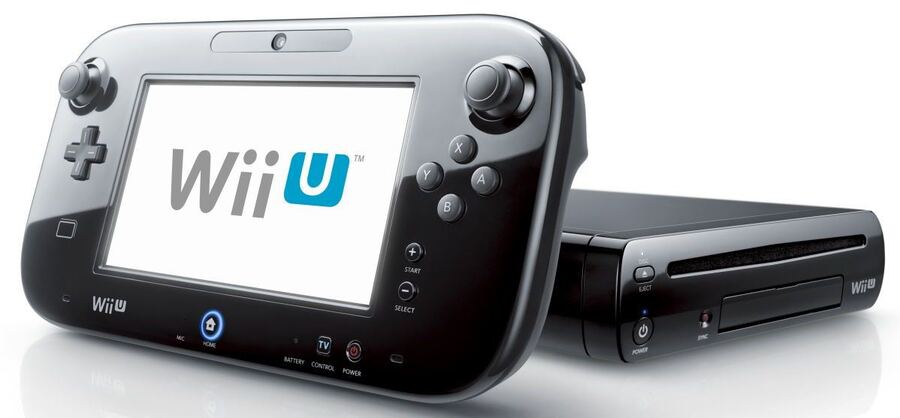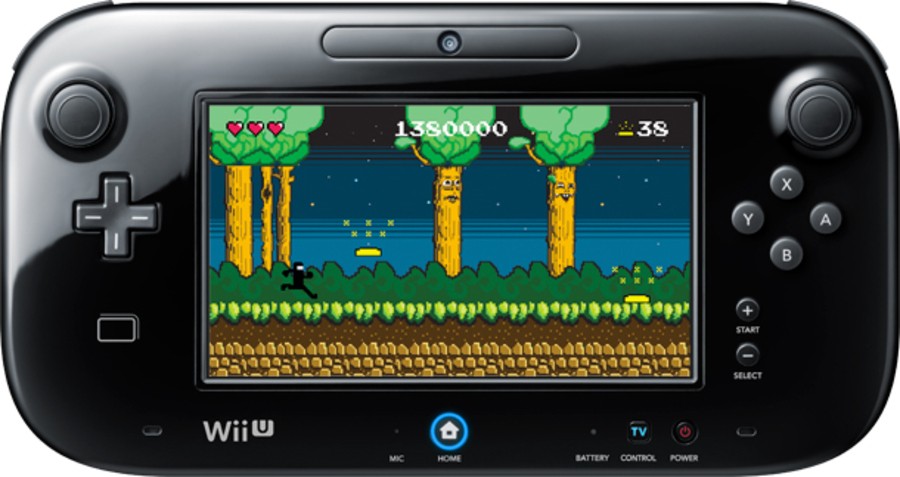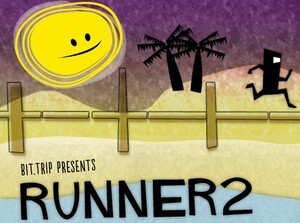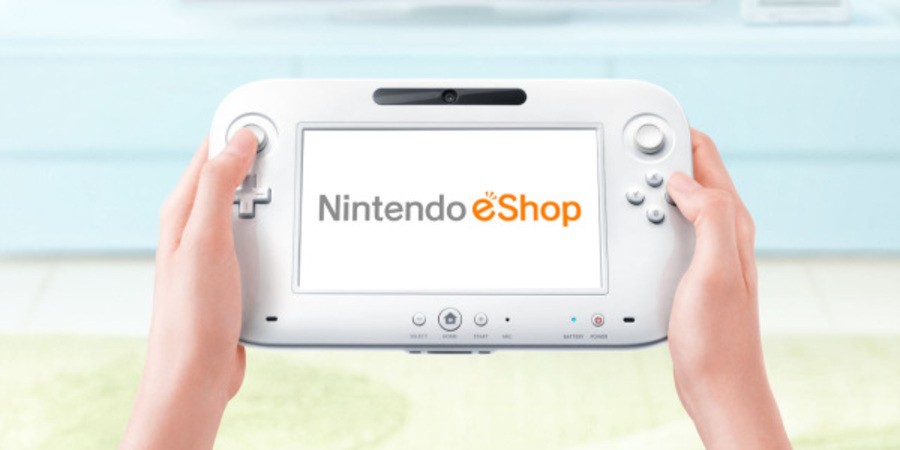
While plenty of developers have stepped up to take a swing at WiiWare, only a pinch have started from scratch and built good names strictly based on their output for the service. Perhaps the biggest success story in this realm is Gaijin Games: as a brand-new studio, the three-strong team grew steadily as it went to bat and hit it out of the park six times over with the retro-infused BIT.TRIP series, which started off as WiiWare exclusives and have since touched PC, Mac, iOS and 3DS, with a new off-shoot, RUNNER2: Future Legend of Rhythm Alien, coming to virtually all HD platforms in early 2013 from a team four times larger than when Gaijin opened its doors.
Gaijin owes a lot to WiiWare, which helped make the decision to bring its next title to Wii U’s eShop a no-brainer. Having gone behind-the-scenes with Nintendo at E3 2010, in a big chamber of a room with a door like a vault, Gaijin was onboard “the moment it was announced,” said co-founder Alex Neuse. “We were way more stoked than we thought (we’d be).” So excited, in fact, that when pre-orders began Neuse drove around town like a man on a mission but found himself unable to find a shop willing to take his cash early, so he says he’ll be camping out along with everyone else in Santa Cruz this Sunday.
Subscribe to Nintendo Life on YouTube841k
With great power comes great possibility
What excites most isn’t the new controller and dizzying potential it may bring — although certainly it brings some degree of tingling — but instead the more expected leaps: in power, an area where Wii sorely fell behind its HD competitors, and in storage. The future feels crisp, but more importantly spacious.
“(Seeing Wii U in HD) was the first moment where (Nintendo’s console) felt like a contender,” said co-founder Mike Roush, “where in the past we always felt like (Wii) was sort of a — obviously, it’s a great platform — but it felt like it was a different category than Xbox and PlayStation 3, to me. Not that that’s bad, but it’s different.”
"Having bigger games is huge for us. If they (Nintendo) had the same restrictions as (WiiWare) on Wii U, we probably wouldn’t be doing (RUNNER2). That was probably the biggest factor for us."
Nintendo knows it, too. Walking around the Big N’s booth at PAX Prime this year, Roush pointed out that the TVs had gotten much bigger than they ever were this past generation. The difference was stark; according to Neuse, Nintendo’s content looked fantastic, “not fuzzy and weird” like before. Wii U is no longer a graphical slouch; while the possibilities are far from endless — the hardware is expected to be leapfrogged by Microsoft’s and Sony’s next boxes — for now, competitive possibilities are at the very least present.
Making way for these possibilities is Nintendo, itself getting out of the way, allowing a far more relaxed size cap for software than WiiWare’s oppressive 40 MB limit, a boundary infamous and derided among developers, forcing compromise or undue struggle with their designs and provoking some developers to ditch the platform altogether. With each of Gaijin’s BIT.TRIP titles filled to the brim with space-hogging audio, it’s no small miracle that even one of them made it out the door in the state they did, let alone the six-arc beast the team ultimately realized; it required nothing short of design ingenuity and tough compromises, especially in the art department. With Wii U, it’s all hakuna matata.

“Having bigger games is huge for us,” Neuse said. “If they had the same restrictions as (WiiWare) on Wii U, we probably wouldn’t be doing (RUNNER2). That was probably the biggest factor for us.”
“Right off the bat for our studio, Wii’s download size was always very constrictive because we did so much stuff with music,” Roush said. ”That was the main thing I was looking at, personally.”
What the new size limit is, or whether one still exists, was not something Gaijin was willing to confirm, but it’s an area where the team expresses no concern. “Whereas it was something we were constantly worrying about before…” Neuse began, with Roush concluding “...we will not worry about it ever again. It’s one thing in my life I’m not worried about.”
“Me too!” Neuse said. “That’s good. We should have these conversations more often.”
Pushing buttons
Power is all well and good, but what Nintendo itself touts is the new GamePad, an evolution of the dual screen concept that the GameCube flirted with to little commercial success and one the DS line of portables has so successfully leveraged. But just as the Wii’s motion controls went neglected or oddly used in third-party games, the concept of the GamePad seems to excite Gaijin more than the realities of development.
“My thing with Nintendo products is that I don’t like that they come out with a cool control scheme or a cool gimmick — I say ‘gimmick’ loosely and not in a bad way — but a lot of larger game companies, to maximize their profits, they have to make a game for all consoles, so the Wii gimmick always ends up being an afterthought,” Roush said. “Say I want to play a new AAA game — the GamePad isn’t going to be utilized the way I want it to (as a player).”

“Nintendo is going to use the GamePad better than anyone else,” Neuse said, “and it’s kind of a bummer because first-parties always want exclusivity. ‘Why don’t you make it for our GamePad, which is so amazing, and we will offer you no incentives other than you’re using a GamePad that’s amazing?’ And then we, as business people, look at it and go, ‘Well, if we were to make a game specifically catering to that GamePad, we are cutting our market potential by 7/8 because there are seven more platforms that we can’t release on if it relies on that GamePad.”
Starting out exclusively on WiiWare, not known to be a widely high-grossing service in and of itself, Gaijin eventually began rolling out the BIT.TRIP series on other platforms to help grow the company’s reach — and riches. “Releasing on one platform where you could just release on eight or nine, there’s just no contest,” Neuse said. “We made the BIT.TRIP games (around the Wii Remote) because we were making Wii games, but we would have sold many, many, many more units if we had never been exclusive to one platform,” he said. “I’m not saying exclusive to Nintendo is the problem, but exclusive to one platform only. You’re seeing us porting our games to different platforms now, but if we had started there our company would be in a much different place.”
“The architecture is a lot better, it’s easier to put games on PC, Xbox and Wii U than (in past generations), and that’s huge.”
The economic realities of developers likely matter very little to the average player, and Wii owners who sought to elevate their console above a mere Wii Sports machine knew this breakdown all too well: a promising popular franchise announcement would lead to an odd spin-off that nobody really asked for, so the game under-performs and the developer turns its back on the console, writing it off as a failed test, or the ol’ chestnut that only Nintendo can sell games on their hardware. Roush and Neuse think that maybe things can change for Nintendo thanks to the extra power and a more level playing field.
“Just from where Wii was in terms of horsepower, AAA companies would do some weird bastardized port and call it a day. Now that Wii U is a contender, there will be more of a market there and they might say “let’s spend some time (on Wii U features),” Roush believes. “The architecture is a lot better, it’s easier to put games on PC, Xbox and Wii U than (in past generations), and that’s huge.”
“The Wii outsold the other platforms, and the big companies made a decision to not really support the Wii because it didn’t have the power,” Neuse said. “Now that it does, will we start to see AAA studios leading with the Wii U?”
All for U

Even though they would later appear on other platforms, BIT.TRIP was designed around the Wii Remote and playing with one offers arguably the best experience over touch screens or a mouse. Had they the resources, Roush would be jazzed to dig into the GamePad as the studio could with the Remote. “I wish we could just make a game for Wii U with GamePad totally integrated, where we could just sit there and get super creative, but it comes down to (the fact that) we just have to feed mouths,” Roush said.
For RUNNER2, Gaijin plans to work in GamePad support but perhaps not to the crazy degree of some of the concepts specifically tailored for Nintendo kicked around the office, like a Game & Watch-style series of minigames. The team settled on using the second screen to more tightly integrate bonus challenges, where grabbing a Famicom cartridge kicks the gameplay over to the GamePad for what Neuse calls a “retro-fun-looking” good time.
“We really wanted to push the Famicom styling of it and keep the Nintendo-ness,” Roush said, adding that these bonus stages were “made for Nintendo”, but will be available on other platforms as well.
“But it’s not going to be as cute,” Neuse added. “If Nintendo allows DLC on the Wii U, which we assume they’re going to, maybe we bring (those other ideas) out down the line.”
Bright horizons
At the time of our interview Nintendo had seemingly communicated little to its developers as to what to expect from the Wii U eShop, and Gaijin found itself as in the dark as the general public, though some screens and details are now emerging. Roush indicated when we spoke that he doubted they'd know anything for sure about the platform until they get their consoles along with everyone else this weekend, although the team suspected that Ninty was hard at work on making the eShop far easier to use than the Wii Shop could have ever dreamed.

The Day 1 catalogue shows promise to Gaijin, with Toki Tori 2 and Chasing Aurora particularly catching the team's eye, not only for the strength of its titles but for the signs that Nintendo is working hard to court smaller studios. “It seems like it’s opening stronger,” Roush said, noting that Nintendo is showing strength in supporting indies, in their experience by doing “as much as they absolutely, positively can for us. Everyone that works at Nintendo are usually the nicest people, they’re champs.”
Neuse also had a few humble requests for the eShop, in case anyone important is listening.
“Demos,” he said. “I don’t want to have to make a demo, but I want to download them! I want it to be user-friendly and save credit card info. I don’t ever want to have to enter my county ever again.
“I just want it to be easy to use, for chrissake.”
We'd like to thank Alex Neuse and Mike Roush for their time.


Comments 24
Ahh! Gaijin really do make awesome games, I truly admire their work!
I love the idea of all these games coming to Wii U and it's nice to see great games making it big that have come from fairly humble origins.
Not just Gaijin but all the other small developers on board too. Wii U sure does have a bright future ahead.
Man I can't wait for more gaijin games. The bit trip games were phenomenal.
However I am concerned that it will be one day like Rare... You know a company starts with great ideas and in the end becomes crap sort of like Grisham with books, ER with too many seasons or Christopher Nolan in films - you do amazing stuff and end up with the latest Batman action crap. You never know with sequels or once you keep doing more of the same.
Famicom mode is looking cool.
Knd of wish you guys would have got Gaijin thoughts on the way Wiiware content is in a seperate shop away from the new eshop taking visability away from their old games which. Could still bring in users.
@Sony_70 When we conducted the interview neither we nor they had any idea what the shop was going to look like.
@Tantan Did you just call Nolan's Batman films rubbish..?
One of my favorite writers interviews one of my favorite developers, then my long-lost favorite editor returns from the dead to defend my favorite movie trilogy? Pinch me.
@James To be fair, Rises was kind of a letdown.
@JonWahlgren
No, no it wasn't. You must have watched a different movie than what I did, my friend.
@FiveDigitLP There was a cut that didn't have so many plot holes and absurd events? Dammit.
Have to agree with Jon here. There was at least one glaring plot hole in every scene, and the ending was so ridiculously happy-go-lucky, it played out like a bad fanfic. The twist at the end also made the rest of the movie retroactively make less sense. That said, I'd still call it a "good" movie, simply for the amazing Nolan atmosphere it was able to recreate at times (the prologue/plane scene was phenomenal), and the visual majesty of many scenes in true IMAX.
/fanboyrant
high five
Yeah, the movie was great until the villain twist. That made it fall like a castle made of cards (I don't know if this expresion is used in english). In spanish is "se derrumbó como un castillo de naipes", not that you care...xD
@DarkCoolEdge In English the expression is "house full of cards" but otherwise exactly the same.
I see that we're getting a little off-topic here; Batman is all well and good as conversation but more appropriate in the Dark Knight Rises forum thread. Pretty please (try to) stick with the article at hand!
Yeah, it's also irrelevant since those moives are epic. There is no need for discussion.
On-the-less-important-topic-which-has-nothing-to-do-with-battymen-or-any-super-hero, I'm interested in this game. (Or could we make the argument that the 8-bit runner sprite is a superhero?)
Gaijin is the biggest scam in gaming since EA started doing $60 yearly roster updates for their sports games. They put zero effort into them and they are on par with thousands of equally bad iOS games that get no credit whatsoever. On the Wii their games seem original but they aren't, they were done 30 years ago on the Atari 2600 and on iOS there are countless similar but infinitely better produced games. I'm all for retro games but Gaijin games offer no compelling gameplay and nothing new to gaming in general other than the feeling of a bad acid trip.
@JebbyDeringer That comment makes me feel angry, but instead of overreacting I will respectfully disagree with you.
@JayceJa I will respectfully disagree with you, as well.
Oh yeah and I read the interview. Gaijin has done the best job of selling me on the Wii U of anyone so far, including Nintendo.
First time visiting NintendoLife, and I must say I'm quite impressed. Thank you for making the effort to interview Gaijin Games; they don't get nearly enough coverage in my opinion. Their games - especially Bit Trip Runner - are some of my favourite games on WiiWare. If you haven't played their games before, you should definitely check out their "Bit Trip Complete" compilation retail disc. It's for Wii, but will also play on your Wii U just fine! Or, of course their individual games are still available for download. I had the privlige of meeting a couple of their developers at Pax East and tried Bit Trip Runner 2; it's going to be a crazy sequel!
Nice to see you drop by @James
Yeah like others said I loved the batman movies but I was disappointed by the third which was total garbage. Like many I came in super excited but came out super disappointed . http://www.cad-comic.com/cad/20120725
Its a phenomenon that happens a lot when greatness loses its edge when it felt like Mozart and now tastes like bubble gum. So I hope gaijin retains what I consider the most brilliant game concept and use of wii exquisite uniqueness in the last decade.
@cold heat I constantly played and play the games on wiiware and to my shame Im still on the fence for both versions of the disc and the 3ds since having spent so much beating them I can't start over
Love Gaijin--Awesome article and I'm glad they're onboard the Wii U train.
@James They could be better, LOL.
Show Comments
Leave A Comment
Hold on there, you need to login to post a comment...